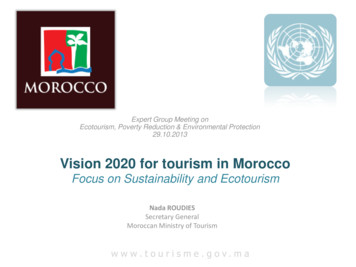Introducing Functional Grammar - Dandelon
IntroducingFunctional GrammarThird editionGeoff Thompson\R RoutledgeTaylor & Francis GroupLONDON AND NEW YORK
ContentsForewordixAcknowledgementsxi1The purposes of linguistic analysis1.11.22142.11415182126Breaking up the sentence — and labelling the parts2.1.1 Recognizing constituents2.1.2 Structural and functional labelsRanksExercisesAn overview of Functional fying clauses and clause constituents2.23Starting points1.1.1 Going in through form1.1.2 Going in through meaningLanguage, context and function: a preliminary explorationExerciseThree kinds of meaning3.1.1 The three metafunctions3.1.2 Three kinds of function in the clause3.1.3 Three kinds of structure in the clause3.1.4 Showing the options: systems networks3.1.5 A fourth metafunctionRegister and genre3.2.1 Register (and the corpus)3.2.2 GenreExercisesInteracting: the interpersonal metafunction454.145Introduction
Contents4.24.34.44.54.64.7Roles of addressers and audienceMood4.3.1 The structure of the Mood4.3.2 Identifying Subject and Finite4.3.3 Meanings of Subject and Finite4.3.4 Mood in non-declarative clauses4.3.5 Mood in text4.3.6 The Residue4.3.7 Modal AdjunctsModality4.4.1 Modality and polarity4.4.2 Types of modality4.4.3 Modal commitment4.4.4 Modal responsibility4.4.5 Modality in textAppraisalInteraction and negotiationInteraction through textExercisesRepresenting the world: the experiential ity: processes and participants5.2.1 Material processes5.2.2 Mental processes5.2.3 Relational processes5.2.4 Verbal processes5.2.5 Other types of processes5.2.6 Other participant roles5.2.7 Circumstances5.2.8 Transitivity in textMore complex aspects of transitivity5.3.1 More on material processes \5.3.2 More on mental processes\5.3.3 More on relational processes5.3.4 Processes in verbal group complexes5.3.5 Participants in causationTransitivity patterns in text5.4.1 Analysing transitivity in clauses and in text5.4.2 Comparing transitivity choices in different 121122128129131131133139142
Contents6Organizing the message: the textual metafunction —Theme6.16.26.36.46.56.66.76.86.97Introduction: making messages fit togetherThemeIdentifying Theme6.3.1 Theme in declarative clauses6.3.2 Theme in non-declarative clausesSpecial thematic structures6.4.1 Thematic equatives6.4.2 Predicated Theme6.4.3 Thematized comment6.4.4 Preposed Theme6.4.5 Passive clauses and ThemeTheme in clause complexesMultiple Theme6.6.1 Conjunctions in Theme6.6.2 Conjunctive and modal Adjuncts in Theme6.6.3 Textual, interpersonal and experiential elements inTheme6.6.4 Interrogatives as multiple ThemesSome issues in Theme analysis6.7.1 Existential 'there' in Theme6.7.2 Interpolations in Theme6.7.3 Preposed attributives6.7.4 Theme in reported clauses6.7.5 Theme and interpersonal grammatical metaphorTheme in text6.8.1 An illustration of Theme in text6.8.2 Other ways of exploring thematic choices6.8.3 Theme in different registersA final note on identifying ThemeExercisesClauses in combination7.17.27.37.4IntroductionUnits of analysisTypes of relations between clauses7.3.1 Logical dependency relations7.3.2 Logico-semantic relationsExpansion7.4.1 81185185186187188193194194vii
Contents7.57.68Organizing the message: the textual metafunction cohesion8.18.28.38.497.4.2 Extending7.4.3 Enhancing7.4.4 Internal and external expansionProjection7.5.1 Quotes and reports7.5.2 Facts7.5.3 Projection in textClause complexing7.6.1 An overview7.6.2 Clause complexing and registerExercisesCohesion and coherenceReference and ellipsis8.2.1 Reference8.2.2 EllipsisConjunctionCohesion and 215215216217220225228232Grammatical IntroductionGrammatical metaphorExperiential and logical metaphorsInterpersonal metaphorsTextual metaphorA cautionary noteExercises10 Implications and applications of Functional Grammar10.110.210.310.4Three-dimensional analysis of textsxA summary review of Functional GrammarUsing Functional Grammar*Closing255255262264266Answers to exercises261Further reading291References3 02Index301viii
Introducing Functional Grammar Third edition Geoff Thompson \ R Routledge Taylor & Francis Group . 2.1.2 Structural and functional labels 18 2.2 Ranks 21 Exercises 26 . 10.2 A summary review of Functional Grammar 262 10.3 Using Functional Grammar * 264 10.4 Closing 266
1.1 Text and grammar 3 1.2 Phonology and grammar 11 1.3 Basic concepts for the study of language 19 1.4 The location of grammar in language; the role of the corpus 31 2 Towards a functional grammar 37 2.1 Towards a grammatical analysis 37 2.2 The lexico-grammar cline 43 2.3 Grammaticalization 46 2.4 Grammar and the corpus 48 2.5 Classes and .
functional linguistics, the ‘languages’ of systemic functional linguistics, lexical func-tional grammar, role and reference grammar,functional grammar, functional discourse grammar, cognitive linguistics etc.). Bernstein used the image of a triangle to represent the nature of knowled
Grammar Express 79 Center Stage 79 Longman Advanced Learners’ Grammar 80 An Introduction to English Grammar 80 Longman Student Grammar of Spoken & Written English 80 Longman Grammar of Spoken & Written English 80 Grammar Correlation Chart KEY BOOK 1 BOOK 2 BOOK 3 BOOK 4 BOOK 5 BOOK 6 8. Grammar.indd 76 27/8/10 09:44:10
IV Grammar/Comp Text ABeka Grammar 10th Grade 5.00 IV Grammar/Comp Text ABeka Grammar 10th Grade 5.00 Grammar/Composition IV ABeka Grammar 10th Grade 3.00 Workbook - Keys ABeka Grammar 12th Grade 10.00 Workbook VI-set ABeka Grammar 12th Grade 20.00 Daily Grams Gra
TURKISH GRAMMAR UPDATED ACADEMIC EDITION 2013 3 TURKISH GRAMMAR I FOREWORD The Turkish Grammar book that you have just started reading is quite different from the grammar books that you read in schools. This kind of Grammar is known as tradit ional grammar. The main differenc
Grammar is a part of learning a language. Grammar can be resulted by the process of teaching and learning. Students cannot learn grammar without giving grammar teaching before. Thornbury (1999) clarifies that grammar is a study of language to form sentences. In this respect, grammar has an important role in sentence construction both i.
Thompson, Geoff. Introducing Functional Grammar. London: Arnold, 1996. The approach to grammar through meaning and function rather than structure, originally developed by Michael Halliday in England. Books and Textbooks on Grammar in Relation to Writing Brathwaite, Rudolph. Writing Through Grammar. McGraw-Hill, 1995. Burnette, Dawn. Daily .
The development of tourism in natural areas (adventure tourism, ecotourism, rural tourism, etc.) necessarily raises the question of the environmental protection of these areas. Current status of nature conservation & biodiversity Ecotourism as a way to make tourism based on the desire to discover nature and to respect, preserve and enhance the natural balance and cultural places and local .























